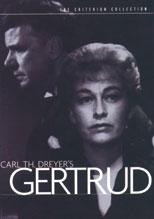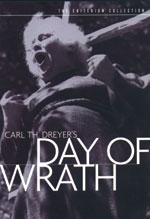LOAD + PLAY
Scooter McCrae on Criterion’s DVD release of Day of Wrath, Gertrud, Ordet and Carl Th. Dreyer — My Métier
 |  |  |
The fine folks at Criterion revolutionized the laserdisc industry by being the first company to release classic films in their proper aspect ratios, packaged with audio commentaries and all sorts of other cineaste bells-and-whistles. In establishing their niche and feeding the flames of consumer passion, however, other companies took notice and began copying Criterion’s success. Now it’s next to impossible to find a DVD without commentary, deleted scenes or some other form of turd polish. So while the Criterion name is still a recognized and respected standard, the company’s most recent achievements haven’t always caught the eyes of consumers who are bombarded every week with "new," "definitive director-approved," "never-before-seen," "unrated-for-the-first-time" DVDs. Frankly, it’s fucking exhausting! Do we really need two different editions of American Pie or the same edition of Evil Dead with four different covers, each one ghastlier then the next?
Now, however, Criterion is back to enact some major ass-kicking with their Carl Theodor Dreyer box set. This wonderful collection consists of three films: Day of Wrath, Ordet and Gertrud. With this release, Criterion more than doubles the shamefully low number of Dreyer titles available on DVD. A fourth disc contains a recent documentary on Dreyer, complete with collaborator interviews and brief archival segments featuring the Danish director himself. Last year Criterion released – with far-too-small media fanfare – Dreyer’s The Passion of Joan of Arc, which, while not a part of this box set, should also be obtained by anyone with a love of eccentric and heartfelt one-of-a-kind cinema.
Dreyer is that rare figure who is considered an auteur – a term used almost exclusively to describe male filmmakers who are difficult or uncompromising in their working methods. While Kubrick and Tarkovsky, two of the best for me, are remembered for many great things, well-developed and emotionally sympathetic female characters are rarely listed among their achievements. Dreyer, on the other hand, focused his attention on women in all of these finely crafted films, and none lose their modernity in that regard.
First up is Day of Wrath (or Vredens dag, 1943), based on a novel by Anne Pedersdotter and lensed while Germany occupied Denmark. Telling the story of a love triangle between an elderly pastor, his young wife and his son from a previous marriage, the film is set in 17th-century Denmark at the height of the Catholic church’s persecution of witchcraft. Here, Dreyer is just beginning to experiment with his trademark use of long takes coupled with apparently simple (but marvelously complex) camera moves, creating surprisingly involving and dynamic, dramatic material from subject matter that is, on the surface, far removed from our daily lives. A sequence in which an old woman (Anna Svierkier), declared to be in league with Satan, is tied to a ladder and burned in the public square is almost unbearable viewing. In Day of Wrath, Dreyer concerns himself with the societal corruption that stems from a zealous faith that, taken for granted and unquestioned, is worth precious little.
Needless to say, this is the best I’ve ever seen this up-until-now murky title look. Occasionally soft but never muddy, sharp and detailed enough to highlight expressive subtleties, this transfer reveals a film as photographically rich as any of Dreyer’s other classics; this facelift should elevate Day of Wrath’s reputation to the ranks of his other, more often quoted works. Bonus features on this disc, as on all three films, include a photo gallery with behind-the-scenes shots of Dreyer at work, as well as some costume and set-design artwork. Also, each disc contains unused or alternate raw-interview footage from the documentary Carl Th. Dreyer — My Métier included on the fourth disc in the box set with various surviving actors from each specific film. Further kudos to Criterion for releasing the first English-subtitled version to properly translate the Dies Irae text crawl at the beginning of the film, which in past incarnations was an English translation of the historical Latin text and not the Danish version presented here (which Dreyer had specially modified from the Latin).
Ordet (1955) is based on an extremely popular Scandinavian play by Kaj Munk (who receives the only credit on the film print!), and examines various levels of religious faith through the interactions, both positive and negative, of two neighboring families in rural Denmark in 1925. Hey, if you already know this film, then you know I’ve left out a hell of a lot with that cursory sentence. But for those who don’t, I don’t want to ruin a single moment of what is at various turns one of the finest, most gut-wrenching and life-affirming films ever made. I remember seeing Ordet at the Walter Reade Theatre in New York City a number of years ago, and everyone was sobbing almost as much as I was. If ever there was a seamless blend of German Expressionist settings and pitch-perfect performances from an acting ensemble, this film is it. Dreyer referred to Einstienian physics as a point of departure for Ordet: “The new science brings us closer to a deeper understanding of the divine and is well on its way to giving a natural explanation for supernatural things that make us realize a deep connection between exact science and intuitive religion.” That, in a nutshell, is the spiritual, emotional and, in the end, logical center of this work.
If you are a Dreyer admirer, Ordet is the most important film in the box set, and it does not disappoint. The transfer is beautiful, and the farm ambiences, ticking clocks and dramatic silences are well served by an equally clean audio track that sets the mood as starkly as the utilitarian spaces in which the story unfolds. Much like Day of Wrath, the best I’d seen this film look before was in the frame blow-ups from David Bordwell’s indispensable book, The Films of Carl Theodor Dreyer. I never thought I’d see either film look as good as those photos, but the quality of both Criterion restorations far surpasses them in crystalline clarity. It’s a testament to the power of these works that their reputations have survived the crappy presentations we’ve had to suffer through.
(1964) revolves around the titular protaganist, who is unfulfilled by her husband and lovers (past and present), and the choices she makes to achieve personal enlightenment. It is a simple tale that presents a series of drawing room quarrels and romantic discussions among a small group of characters, most of which are presented in unflinching extended real-time takes with Dreyer’s deceptively complex camera moves following the subtle creases of a furrowed brow or fidgeting hand. Critically hated on its initial release, and still considered by some to be a blight upon an otherwise brilliant career, Dreyer’s final film is a challenging piece that rewards the receptive viewer and alienates to tears those who simply can’t cotton to it. Imagine a radically linear re-think of Last Year at Marienbad, in which that pretzel-twisted film is hammered flat on an anvil of logic, and some of Gertrud’s difficulties become apparent. Unlike Resnais’s vastly self-reflexive crystal chandelier of refracted story elements, Gertrud is a film in which all overt symbolism has been stripped away like paint from a powdery, white wall. This film is a gaping chasm of emptiness that invites the adventurous viewer to fill in the blanks of meaning with the details of their own life experiences. Few films have dared to ask so much from a viewer, but if Dreyer and his rhythms hook you, you’ll feel satiated.
While this transfer of Dreyer’s only wide-screen film looks very good, you’d think it would look that much better than the others. Unfortunately it doesn’t. This is not a complaint aimed at Criterion, merely an observation of the less-than-ideal circumstances under which these elements must have been stored. In addition to the unused interview material of surviving Dreyer colleagues involved in this production, there’s roughly nine minutes of raw Dreyer footage. This silent stock, accompanied by melodramatic music that Dreyer would probably despise, includes him meeting François Truffaut, Jean-Luc Godard and Anna Karina at the film’s 1964 French premiere.
Finally, as for Carl Theodeor Dreyer — My Métier, the documentary, the less said the better. The film is so pretentious in execution, with seemingly endless, kaleidoscopic imagery accompanied by an almost non-stop over-emphatic score, that it quickly grows tiresome. I can only imagine how disappointed Dreyer would have been to see so much artifice and empty stylization at work to commemorate works of such intellectual honesty and subtle simplicity. My recommendation is to remove the documentary from the box set and insert a copy of The Passion of Joan of Arc. These films deserve the better company of a fellow masterpiece. And hey, Criterion, how about working on Dreyer’s desperately-in-need-of-restoring Vampyr for next year?
For more information visit criterionco.com.
VOD CALENDAR


 See the VOD Calendar →
See the VOD Calendar →


